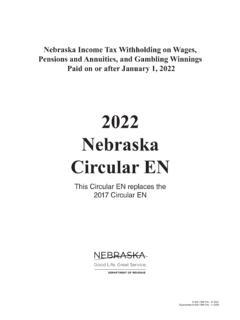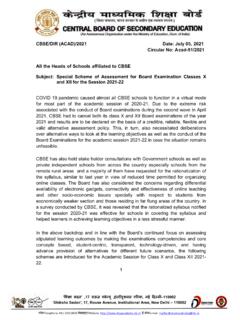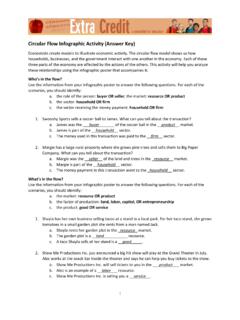Transcription of AC 150/5200-30D, Airport Winter Safety and Operations, 29 ...
1 Department of Transportation Federal Aviation Administration Advisory circular Subject: Airport Field Condition Assessments and Winter Operations Safety Date: 7/29/2016 Initiated By: AAS-300 AC No: 150/5200-30D 1 PURPOSE. This advisory circular (AC) provides guidance to assist Airport operators in developing a snow and ice control plan, assessing and reporting Airport conditions through the utilization of the Runway Condition Assessment Matrix (RCAM), and establishing snow removal and control procedures. 2 CANCELLATION. This AC cancels AC 150/5200-30C, Airport Winter Safety and Operations, dated December 9, 2008. 3 APPLICATION. The information contained in this AC provides guidance for the Airport operators in development of plans, methods, and procedures for identifying, reporting, and removal of Airport contaminants.
2 The use of this guidance is an acceptable means of compliance, for airports certificated under Title 14 Code of Federal Regulations (CFR) part 139, Certification of Airports. The use of this AC is also a method of compliance for federally obligated airports. Furthermore, use of the specifications in this AC is mandatory for projects funded under the Airport Improvement Program (AIP) or with revenue from the Passenger Facility Charge (PFC) program. For implementation purposes, all certificated airports must submit revised Snow Ice Control Plans to the FAA no later than September 1, 2016, for approval. The Federal NOTAM System is the primary means of conveying Airport condition information by certificated and federally obligated airports. Effective October 1, 2016, the Federal NOTAM System will incorporate the new reporting criteria and methodology contained in this AC.
3 7/29/2016 AC 150/5200-30D ii 4 PRINCIPAL CHANGES. The AC incorporates the following principal changes: Updates the title of the AC to communicate the inclusion of guidance on field assessments beyond Winter conditions. Introduces the Runway Condition Assessment Matrix (RCAM) and procedures for use and application. Expands on using current NOTAM system technology for Airport condition Adds new information to the Airfield Clearing Priorities for the Snow and Ice Plan. Adds definitions of contaminants in Paragraph 5. Defines vehicle and pilot reported braking action and updates terminology: Good, , Medium (previously known as Fair), Medium-to-Poor, Poor, and Nil. Adds conditions not monitored information for Airport operators to use when the is not monitored due to operations hours or staffing. Adds the new acronym RwyCC for Runway Condition Code.
4 8. Removes the capability to report friction (Mu) values (replaced by RwyCCs). 9. Adds information on snow removal from Engineered Material Arresting Systems. 10. Adds new Appendix A, Sample Airport Condition Assessment Worksheet. 11. Adds new Appendix F, Runway Condition Assessment Matrix (RCAM) (For Operators Use Only). Provides origin and background on the Takeoff and Landing Performance Aviation Rulemaking Committee. Identifies the approved list of layered contaminants. 14. Introduces percentage based contaminant reporting by runway third. 15. Limits use of Vehicle Braking Action Reports to non-runway environment ( , , aprons, holding bays, etc.). Provides examples of how multiple contaminants are to be illustrated. 17. Revises and supplements the list of questions for Snow and Ice Control Plans 18.(SICPs).
5 Provides a decision tree for an overview of the basic RCAM process. Related Code of Federal Regulations (CFRs) and Reference Materials. The following are FAA regulations and publications (see current versions) from which material has been extracted for the preparation of this AC. They will continue to be the authoritative source of revisions to this AC. These references also contain additional 7/29/2016 AC 150/5200-30D iii resource material that may be useful in special situations, but their immediate availability to Airport operators is not considered necessary to accomplish the basic operational purpose of this AC. Electronic versions of these documents are available online. Electronic CFRs are available at : 14 CFR Part 139, Certification of Airports. b. 14 CFR Part 25, Airworthiness Standards: Transport Category Airplanes.
6 C. 14 CFR Part 91, General Operating and Flight Rules. d. 14 CFR Part 121, Air Carrier Certification. e. 14 CFR Part 135, Operating Requirements: Commuter and On Demand Operations and Rules Governing Persons On Board Such Aircraft. f. 49 CFR Part 1542, Airport Security. g. 49 CFR Part 1544, Aircraft Operator Security: Air Carriers and Commercial Operators. Air Traffic publications are available at : FAA Order JO , Flight Services. b. FAA Order JO , Air Traffic Control. c. FAA Order JO , Facility Operation and Administration. d. FAA Order JO , Notices to Airmen (NOTAMs). e. Aeronautical Information Manual (AIM). f. Pilot/Controller Glossary (P/CG). Airport ACs (150 series) are available at : a. AC 150/5300-13, Airport Design. b. AC 150/5200-28, Notices to Airmen (NOTAMs) for Airport Operators. c. AC 150/5320-12, Measurement, Construction, and Maintenance of Skid Resistant Airport Pavement Surfaces.
7 Other FAA ACs are available at : a. AC 25-31, Takeoff Performance Data for Operations on Contaminated Runways. b. AC 25-32, Landing Performance Data for Time-of-Arrival Landing Performance Assessments. c. AC 91-79, Mitigating the Risks of a Runway Overrun Upon Landing. d. AC , Operational Landing Distances for Wet Runways; Transport Category Airplanes. 7/29/2016 AC 150/5200-30D iv Other FAA Orders and Notices are available at : a. FAA Order , Flight Standards Information Management System. b. FAA Order , Airport Compliance Manual. Michael J. O Donnell Director of Airport Safety and Standards 7/29/2016 AC 150/5200-30D CONTENTS Paragraph Page v CHAPTER 1. INTRODUCTION .. 1-1 Overview.. 1-1 Background.. 1-1 Snow and Ice Control Committee.. 1-2 Airport Snow and Ice Control Committee (SICC).. 1-2 Snow Control Center (SCC).
8 1-3 Airfield Clearing Priorities for the Snow and Ice Control Plan (SICP).. 1-3 Terminal and Landside Ground Side Priority.. 1-4 Airfield Target Clearance 1-5 Staffing for Operation of Snow and Ice Control Equipment.. 1-6 Sizing and Storage of Snow and Ice Control Equipment.. 1-7 FAA-Approved Runway Friction Measuring Equipment.. 1-7 Definitions.. 1-8 2. THE SNOW AND ICE CONTROL PLAN .. 2-1 Safety Requirements.. 2-1 Airport Operators.. 2-1 Snow and Ice Control Plans.. 2-1 Topics for Pre- and Post-Season SICC Meetings.. 2-3 Outlining a Snow and Ice Control Plan (SICP).. 2-5 Topics for Writing Instructions and Procedures for Winter Operations and .. 2-5 Runway Incursion Mitigation and Operations During Non-Towered Air Traffic Periods.. 2-6 Staff Training and Recordkeeping.. 2-7 Other Related Items.
9 2-7 3. FORECAST TECHNOLOGY FOR Airport OPERATORS .. 3-1 Weather Forecasting.. 3-1 FAA Forecasting Research and Development for Airport Operators.. 3-1 Forecasting Runway Surface Conditions.. 3-4 AC 150/5200-30D vi CHAPTER 4. SNOW CLEARING OPERATIONS AND ICE PREVENTION .. 4-1 Introduction.. 4-1 Snow Clearing Principles.. 4-1 Controlling Snow Drifts.. 4-11 Snow Disposal.. 4-12 Methods for Ice Control and Removal.. 4-13 Approved Chemicals.. 4-14 Runway Friction Improvements.. 4-16 Sand.. 4-18 5. SURFACE ASSESSMENT AND REPORTING .. 5-1 Airport Operator Responsibility.. 5-1 Runway Friction Surveys.. 5-2 Runway Condition Assessments.. 5-5 Applying the RCAM to a Runway Assessment.. 5-14 Reportable Contaminants without Performance Data.. 5-17 Condition Reporting.. 5-17 Information Exchanged Between the Airport and Pilots.
10 5-17 Requirements for Runway, Taxiway, and Apron and Holding Bay Closures. 5-19 Continuous Monitoring.. 5-20 Letter of Agreement (LOA) Between Airport Operator and Air Traffic Control .. 5-21 Airport Records and Log Controls.. 5-21 Using Conditions Not Monitored NOTAMs.. 5-22 Winter NOTAM Abbreviations.. 5-22 A. SAMPLE Airport CONDITIONS ASSESSMENT WORKSHEET .. A-1 APPENDIX B. DEVELOPMENT OF RECOMMENDED SNOW BANK HEIGHT PROFILES .. B-1 APPENDIX C. SNOW AND ICE CONTROL AS A MATERIALS-HANDLING PROBLEM .. C-1 APPENDIX D. DECELEROMETERS THAT MEET FAA TECHNICAL SPECIFICATIONS .. D-1 APPENDIX E. PERFORMANCE SPECIFICATION FOR DECELEROMETERS .. E-1 7/29/2016 AC 150/5200-30D vii APPENDIX F. RUNWAY CONDITION ASSESSMENT MATRIX (RCAM) (FOR Airport OPERATORS USE ONLY) .. F-1 FIGURES Figure 1-1. Example of Prioritized Paved Areas for the Snow and Ice Control 1-4 Figure 3-1.
















